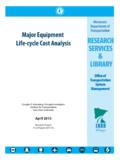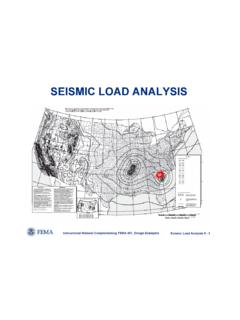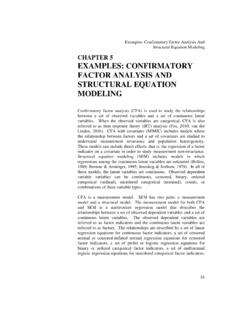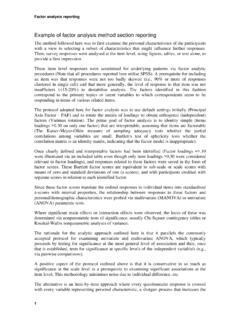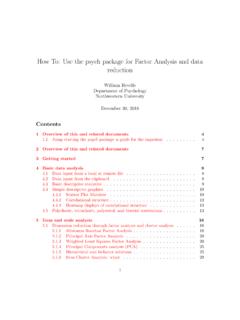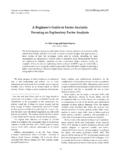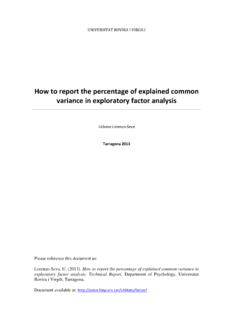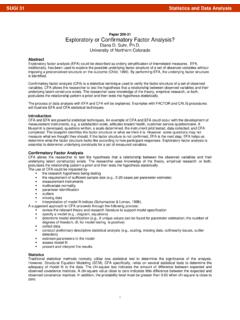Transcription of Creating an Analysis Plan
1 PARTICIPANT WORKBOOK Measures of association analysistable shells Descriptive Analysis univariable assess calculate testingvariables bivariable design justify confidence intervals software stratify plan confounding statistical Creating an Analysis Plan Created: 2013 Creating an Analysis Plan. Atlanta, GA: Centers for Disease Control and Prevention (CDC), 2013. Creating AN Analysis PLANPARTICIPANT WORKBOOK |2 Creating an Analysis Plan Table Of Contents INTRODUCTION .. 3 LEARNING OBJECTIVES .. 3 ESTIMATED COMPLETION TIME .. 4 TARGET AUDIENCE .. 4 PREWORK AND PREREQUISITES .. 4 ABOUT THIS WORKBOOK AND THE ACTIVITY WORKBOOK .. 4 ICON GLOSSARY .. 4 ACKNOWLEDGEMENTS .. 5 SECTION 1: OVERVIEW OF DATA Analysis .. 6 STEPS TO COMPLETE BEFORE ANALYZING DATA.
2 6 OVERVIEW OF STEPS IN ANALYZING NCD DATA .. 6 TYPES OF STATISTICAL 8 SECTION 2: Analysis PLAN .. 11 OVERVIEW .. 11 RESEARCH QUESTIONS AND/OR HYPOTHESES .. 11 DATASET(S) TO BE USED .. 11 INCLUSION/EXCLUSION CRITERIA .. 13 VARIABLES TO BE USED IN THE MAIN Analysis .. 13 STATISTICAL METHODS AND SOFTWARE .. 15 KEY POINTS TO REMEMBER .. 16 OVERVIEW OF PREPARING TABLE SHELLS .. 23 TYPES OF TABLE SHELLS .. 24 KEY POINTS TO REMEMBER .. 32 RESOURCES .. 38 APPENDICES .. 40 APPENDIX A .. 41 APPENDIX B .. 42 Creating AN Analysis PLAN PARTICIPANT WORKBOOK |3 Introduction The Creating an Analysis Plan training module is one of three modules that will provide you with the skills needed to analyze and interpret quantitative 1 noncommunicable disease (NCD) data.
3 When you apply these quantitative Analysis skills, you will turn data into information that can be used to make informed decisions on public health program and policy recommendations. An Analysis plan helps you think through the data you will collect, what you will use it for, and how you will analyze it. Creating an Analysis plan is an important way to ensure that you collect all the data you need and that you use all the data you collect. Analysis planning can be an invaluable investment of time. It can help you select the most appropriate research methods and statistical tools. It will ensure that the way you collect your data and structure your database will help you get reliable analytic results . LEARNING OBJECTIVES Given information about a noncommunicable (NCD) health problem and a request for health-related information, you will be able to create an Analysis plan that includes the following: Research question(s) and/or hypotheses, Dataset(s) to be used, Inclusion/exclusion criteria, Variables to be used in the main Analysis , Statistical methods and software to be used, and, Table shells to prepare for:oUnivariable Analysis ,oBivariable Analysis ,1 Collecting, analyzing, and reporting qualitative data is a valuable epidemiologic skill that requires careful consideration but will not be covered in this module.
4 Data into Action Analyzing and Interpreting Large Datasets Managing Data Creating an Analysis Plan Creating AN Analysis PLANPARTICIPANT WORKBOOK |4oCalculating measures of association, and,oAssessing for confounding and effect measure COMPLETION TIME The workbook should take between 6 and 7 hours to complete. TARGET AUDIENCE The workbook is designed for FETP residents who specialize in NCDs; however, you can also complete the module if you are working in the infectious disease area. PRE-WORK AND PREREQUISITES Before participating in this training module, you must complete training in: Basic epidemiology and surveillance Basic analysisABOUT THIS WORKBOOK AND THE ACTIVITY WORKBOOK The format of the Participant Workbook consists of 3 sections.
5 You will read information about Creating an Analysis plan and complete 2 exercises to practice the skills and knowledge learned. At the end of the training module you will access the Activity Workbook and complete a skill assessment which combines all skills taught. ICON GLOSSARY The following icons are used in this workbook: Image Type Image Meaning Activity Icon Activity, exercise, assessment or case study that you will complete Stop Icon Stop and consult with your facilitator/mentor for further instruction Tip Icon Supplemental information, or key idea to note and remember Creating AN Analysis PLAN PARTICIPANT WORKBOOK |5 ACKNOWLEDGEMENTS Many thanks to the following colleagues from the Centers for Disease Control and Prevention for: 1)Providing detailed feedback and guidance.
6 Lina Balluz, ScD, MPH, Office of Surveillance, Epidemiology andLaboratory, Division of Behavioral Surveillance Richard Dicker, MD, MS, Center for Global Health, Division of GlobalHealth Protection Antonio Neri, MD, MPH, National Center for Chronic DiseasePrevention and Health Promotion, Division of Cancer Prevention andControl Mona Saraiya, MD, MPH, National Center for Chronic DiseasePrevention and Health Promotion, Division of Cancer Prevention andControl2)Developing the hypertension case study for the Practice Exercises: Fleetwood Loustalot, PhD, FNP, National Center for Chronic DiseasePrevention and Health Promotion, Division of Heart Disease andStroke Prevention Andrea Neiman, MPH, PhD, National Center for Chronic DiseasePrevention and Health Promotion, Division of Heart Disease andStroke Prevention Cathleen Gillespie, MS, National Center for Chronic DiseasePrevention and Health Promotion, Division of Heart Disease andStroke Prevention Edward Gregg, PhD, National Center for Chronic Disease Preventionand Health Promotion, Division of Diabetes TranslationSome of the content of this module was taken from a training manual developed by the CDC s Division of Epidemiology and Surveillance Capacity Development.
7 Advanced Management and Analysis of Data Using Epi Info for Windows: Risk Factors for Sexually Transmitted Infections in Kuwadzana, Zimbabwe; 2006. Creating AN Analysis PLANPARTICIPANT WORKBOOK |6 Section 1: Overview of Data Analysis STEPS TO COMPLETE BEFORE ANALYZING DATAT here are several steps you must complete before you analyze data. For this training, these steps have been divided into two modules Create an Analysis Plan and Manage Data. The main tasks are as follows: an Analysis plan Identify research questions and/or hypotheses. Select and access a dataset. List inclusion/exclusion criteria. Review the data to determine the variables to be used in the mainanalysis. Select the appropriate statistical methods and software.
8 Create table the data Create a data dictionary. Create a working copy of the dataset. Clean the data in the working file. Create an Analysis OF STEPS IN ANALYZING NCD DATAThe focus of this and subsequent data Analysis modules is on analyzing NCD data. In order to accurately create an Analysis plan, you should be familiar with the steps in analyzing NCD data, for example, from a large complex survey. The steps are as follows: 1. Conduct univariable characteristics of the populationDescribe the sample population by person, place, and timecharacteristics. Summarize variables using population-levelfrequencies and calculate stratified frequencies across important sub-groups (if any). Determine the frequency distribution of AN Analysis PLAN PARTICIPANT WORKBOOK | frequency of outcome variablesThe objective of many surveys is to estimate the prevalence of one ormore health-related behaviors, practices, or outcomes, such as seat-belt use, smoking, hypertension, or diabetes.
9 Univariable analysesshould include the frequency distribution of these variables and alsoconfidence intervals for the prevalence bivariable the data in two-variable tables:Sometimes the characterization of the population can be extended totwo-variable tables, such as age by sex. For surveys in which theobjective is to estimate prevalence, the data are often analyzed bypopulation characteristics. For example, you can use two-variabletables to determine whether the prevalence varies by sex oreducation level. F or analytic studies in which the objective is toquantify associations between exposures and outcomes, the two-variable table displays the core result, with rows representing levelsof exposure and columns representing presence or absence of and interpret measures of association:Determine the magnitude of association between an exposurevariable and an outcome variable.
10 If there are two or morepopulations, consider comparing their demographic data to determinewhether they were different before the study/ Analysis was confidence intervals and/or statistical significance:Utilize confidence intervals to quantify the variability of the data inyour Analysis . Use t-tests for continuous data, chi-square tests forcategorical data, and other statistical tests as appropriate for the datato determine whether the results are statistically significant. for effect measure modifcation:Effect measure modification (also known as effect modification ) ispresent when an effect measure such as sex, age or geographiclocation is different at several levels in an exposure-diseaserelationship. This is evaluated through statistical assessment ofinteraction between the effect of potential confounders: Creating AN Analysis PLANPARTICIPANT WORKBOOK |8 Confounding is an apparent association between disease and exposure resulting from a third factor that was not considered.











